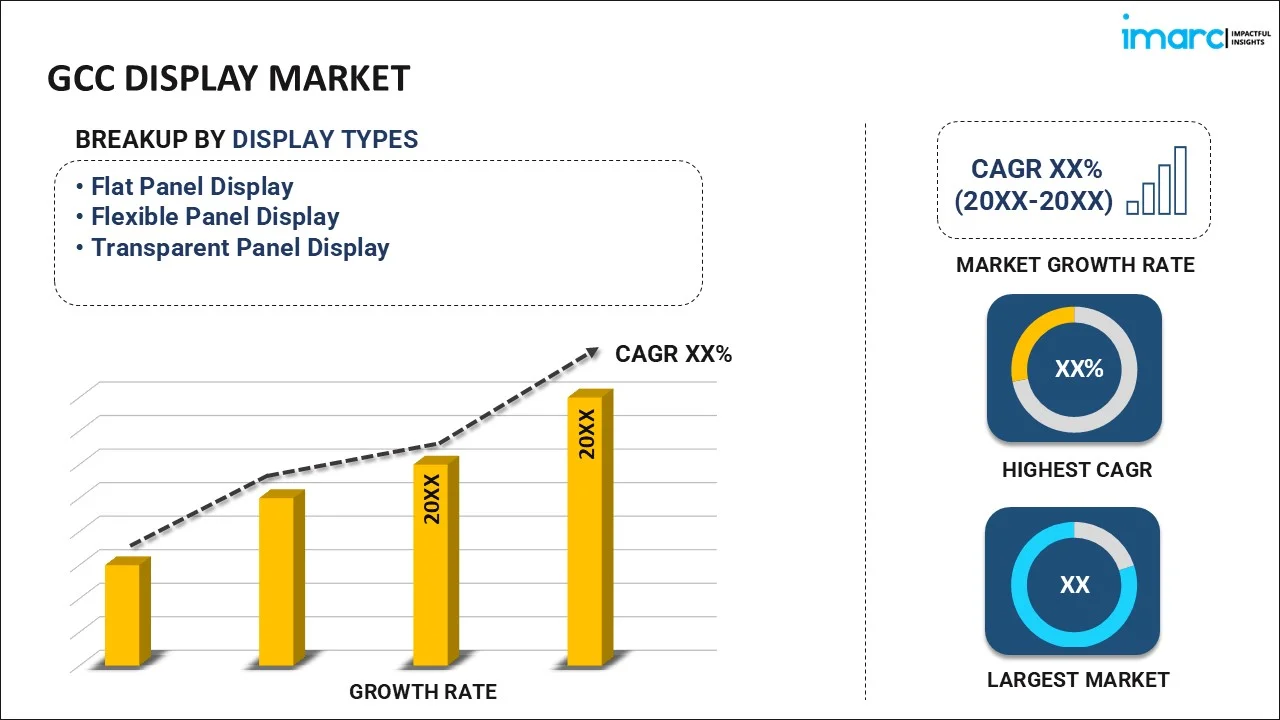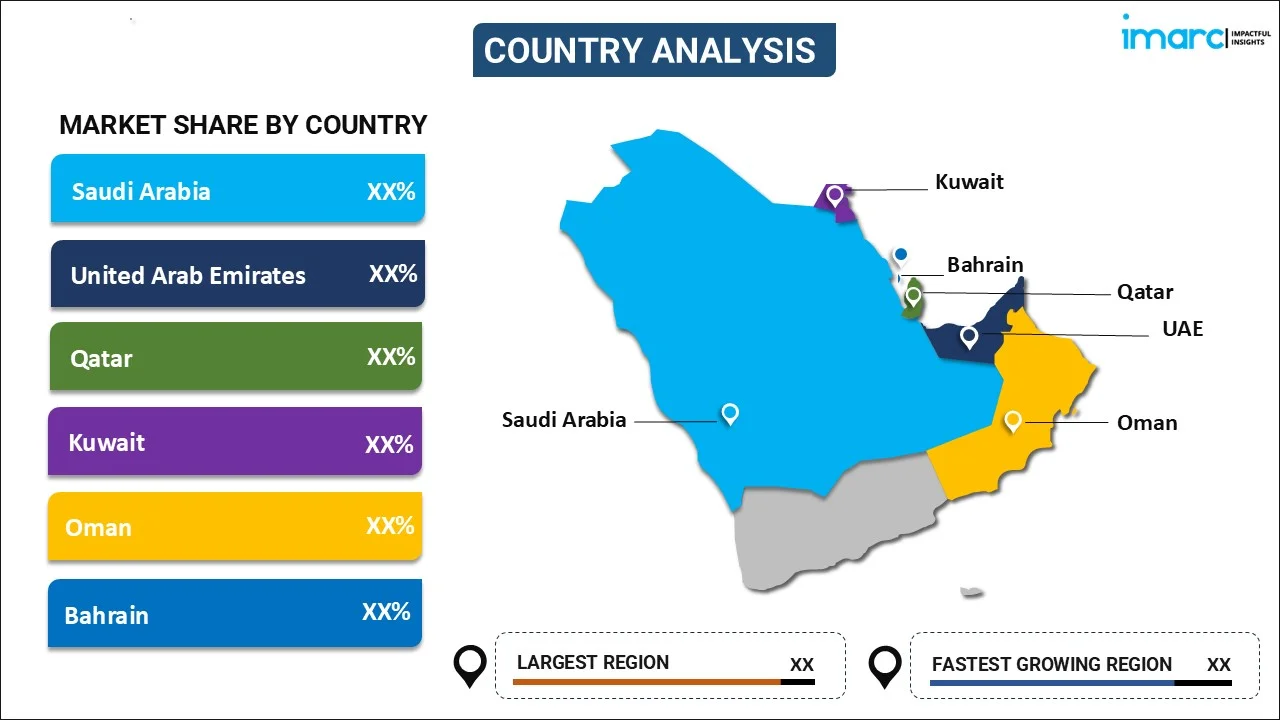
GCC Display Market Report by Display Type (Flat Panel Display, Flexible Panel Display, Transparent Panel Display), Technology (OLED, Quantum Dot, LED, LCD, E-Paper, and Others), Application (Smartphone and Tablet, Smart Wearable, Television and Digital Signage, PC and Laptop, Vehicle Display, and Others), Industry Vertical (BFSI, Retail, Healthcare, Consumer Electronics, Military and Defense, Automotive, and Others), and Country 2025-2033
Market Overview:
The GCC display market size reached USD 3.5 Billion in 2024. Looking forward, IMARC Group expects the market to reach USD 5.6 Billion by 2033, exhibiting a growth rate (CAGR) of 5.1% during 2025-2033. The widespread adoption of advanced display technologies, governments in the region are investing in smart city initiatives and the use of digital signage for promotion and customer engagement represent some of the key factors driving the market.
|
Report Attribute
|
Key Statistics
|
|---|---|
|
Base Year
|
2024 |
|
Forecast Years
|
2025-2033
|
|
Historical Years
|
2019-2024
|
| Market Size in 2024 | USD 3.5 Billion |
| Market Forecast in 2033 | USD 5.6 Billion |
| Market Growth Rate (2025-2033) | 5.1% |
Displays are a critical component of modern technology, used in a myriad of devices to visually present information to users. They are employed in various forms of electronics, such as smartphones, computers, televisions, and digital signage. The choice of display technology greatly influences the user's experience, impacting factors such as color reproduction, power consumption, response time, and viewing angles. It also has implications for the device's design and form factor. For instance, the flexibility of OLEDs has paved the way for foldable or curved displays. Additionally, the resolution of a display refers to the number of distinct pixels that can be displayed. Higher resolution leads to sharper images and better overall image quality. Popular resolutions include Full HD, 4K, and 8K, each offering progressively better quality. Besides this, they are equipped with display interfaces, which are the physical connectors and protocols used to transmit video data from a source, such as a computer or game console to a display. Some of the common interfaces include HDMI, DisplayPort, and USB type-C which can also carry audio, touch data, and other types of data.
GCC Display Market Trends:
The GCC display market is driven by rapid technological advancements. This can be attributed to the widespread adoption of advanced display technologies, such as OLED, QLED, and 4K resolution is increasing in the region. The push for innovation in the consumer electronics sector, especially in smartphones and televisions, is driving this trend. Moreover, the robust economic growth in the GCC region, powered by oil and non-oil sectors, has led to increased purchasing power. This, in turn, drives demand for consumer electronics, including products with advanced display technologies. Apart from this, governments in the GCC are investing in smart city initiatives, which often involve the use of digital displays for information dissemination, wayfinding, and advertising, which is creating a positive market outlook. Furthermore, the adoption of digital learning in educational institutions on account of the sudden outbreak of coronavirus disease (COVID-19) also contributes to the demand for displays across the region. Furthermore, the retail sector in the GCC region is expanding, and the use of digital signage for promotion and customer engagement is on the rise, this is providing an impetus to the market. Additionally, the GCC region hosts numerous international events and is a global hub for tourism. Displays play a crucial role in these sectors, used for information dissemination, advertising, and entertainment, this providing a boost to the display market.
GCC Display Market Segmentation:
IMARC Group provides an analysis of the key trends in each segment of the GCC display market report, along with forecasts at the regional and country levels for 2025-2033. Our report has categorized the market based on display type, technology, application, and industry vertical.
Display Type Insights:

- Flat Panel Display
- Flexible Panel Display
- Transparent Panel Display
The report has provided a detailed breakup and analysis of the GCC display market based on the display type. This includes flat panel display, flexible panel display and transparent panel display.
Technology Insights:
- OLED
- Quantum Dot
- LED
- LCD
- E-Paper
- Others
A detailed breakup and analysis of the GCC display market based on the technology has also been provided in the report. This includes OLED, quantum dot, LED, LCD, e-paper, and others.
Application Insights:
- Smartphone and Tablet
- Smart Wearable
- Television and Digital Signage
- PC and Laptop
- Vehicle Display
- Others
The report has provided a detailed breakup and analysis of the GCC display market based on the application. This includes smartphone and tablet, smart wearable, television and digital signage, pc and laptop, vehicle display, and others.
Industry Vertical Insights:
- BFSI
- Retail
- Healthcare
- Consumer Electronics
- Military and Defense
- Automotive
- Others
The report has provided a detailed breakup and analysis of the GCC display market based on the industry vertical. This includes BFSI, retail, healthcare, consumer electronics, military and defense, automotive, and others.
Country Insights:

- Saudi Arabia
- UAE
- Qatar
- Bahrain
- Kuwait
- Oman
The report has also provided a comprehensive analysis of all the major regional markets, which include Saudi Arabia, UAE, Qatar, Bahrain, Kuwait and Oman.
Competitive Landscape:
The report has also provided a comprehensive analysis of the competitive landscape in the market. Competitive analysis such as market structure, key player positioning, top winning strategies, competitive dashboard, and company evaluation quadrant has been covered in the report. Also, detailed profiles of all major companies have been provided.
GCC Display Report Coverage:
| Report Features | Details |
|---|---|
| Base Year of the Analysis | 2024 |
| Historical Period | 2019-2024 |
| Forecast Period | 2025-2033 |
| Units | Billion USD |
| Scope of the Report | Exploration of Historical and Forecast Trends, Industry Catalysts and Challenges, Segment-Wise Historical and Predictive Market Assessment:
|
| Display Types Covered | Flat Panel Display, Flexible Panel Display, Transparent Panel Display |
| Technologies Covered | OLED, Quantum Dot, LED, LCD, E-Paper, Others |
| Applications Covered | Smartphone and Tablet, Smart Wearable, Television and Digital Signage, PC and Laptop, Vehicle Display, Others |
| Industry Verticals Covered | BFSI, Retail, Healthcare, Consumer Electronics, Military and Defense, Automotive, Others |
| Countries Covered | Saudi Arabia, UAE, Qatar, Bahrain, Kuwait, Oman |
| Customization Scope | 10% Free Customization |
| Post-Sale Analyst Support | 10-12 Weeks |
| Delivery Format | PDF and Excel through Email (We can also provide the editable version of the report in PPT/Word format on special request) |
Key Questions Answered in This Report:
- How has the GCC display market performed so far and how will it perform in the coming years?
- What has been the impact of COVID-19 on the GCC display market?
- What is the breakup of the GCC display market on the basis of display type?
- What is the breakup of the GCC display market on the basis of technology?
- What is the breakup of the GCC display market on the basis of application?
- What is the breakup of the GCC display market on the basis of industry vertical?
- What are the various stages in the value chain of the GCC display market?
- What are the key driving factors and challenges in the GCC display market?
- What is the structure of the GCC display market and who are the key players?
- What is the degree of competition in the GCC display market?
Key Benefits for Stakeholders:
- IMARC’s report offers a comprehensive quantitative analysis of various market segments, historical and current market trends, market forecasts, and dynamics of the GCC display market from 2019-2033.
- The research study provides the latest information on the market drivers, challenges, and opportunities in the GCC display market.
- Porter's five forces analysis assist stakeholders in assessing the impact of new entrants, competitive rivalry, supplier power, buyer power, and the threat of substitution. It helps stakeholders to analyze the level of competition within the GCC display industry and its attractiveness.
- Competitive landscape allows stakeholders to understand their competitive environment and provides an insight into the current positions of key players in the market.
Need more help?
- Speak to our experienced analysts for insights on the current market scenarios.
- Include additional segments and countries to customize the report as per your requirement.
- Gain an unparalleled competitive advantage in your domain by understanding how to utilize the report and positively impacting your operations and revenue.
- For further assistance, please connect with our analysts.
 Request Customization
Request Customization
 Speak to an Analyst
Speak to an Analyst
 Request Brochure
Request Brochure
 Inquire Before Buying
Inquire Before Buying




.webp)




.webp)












